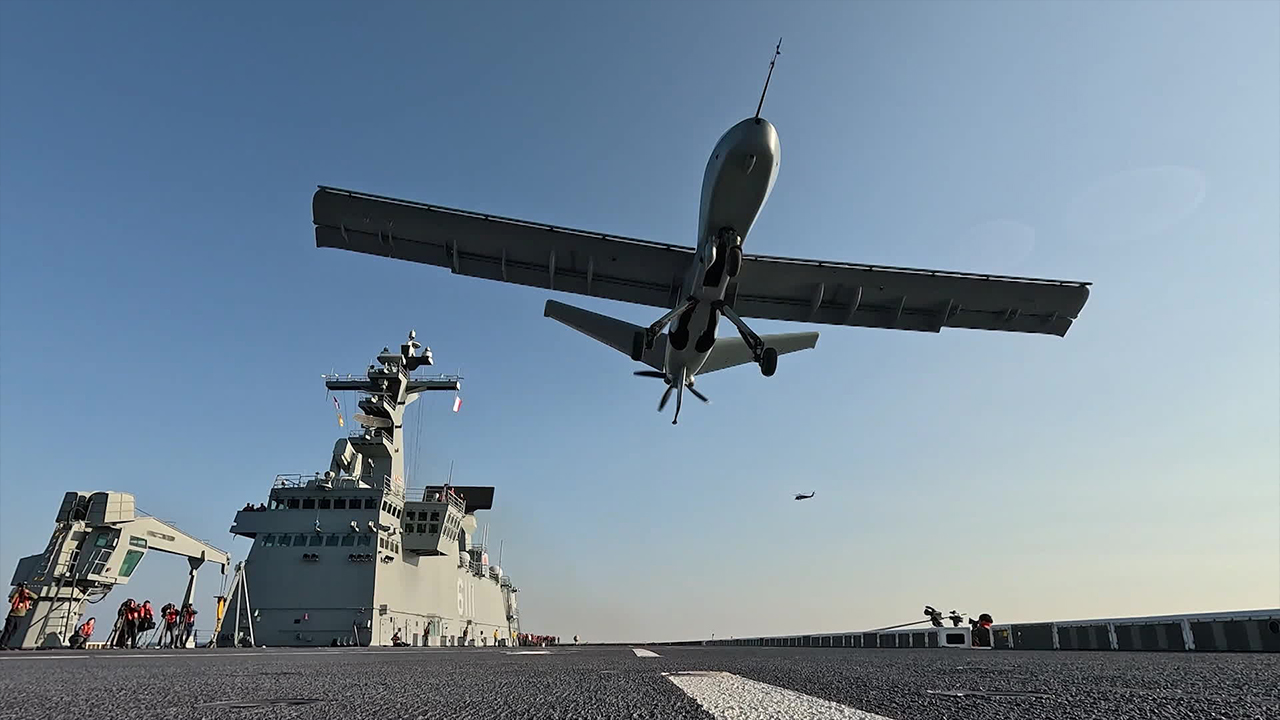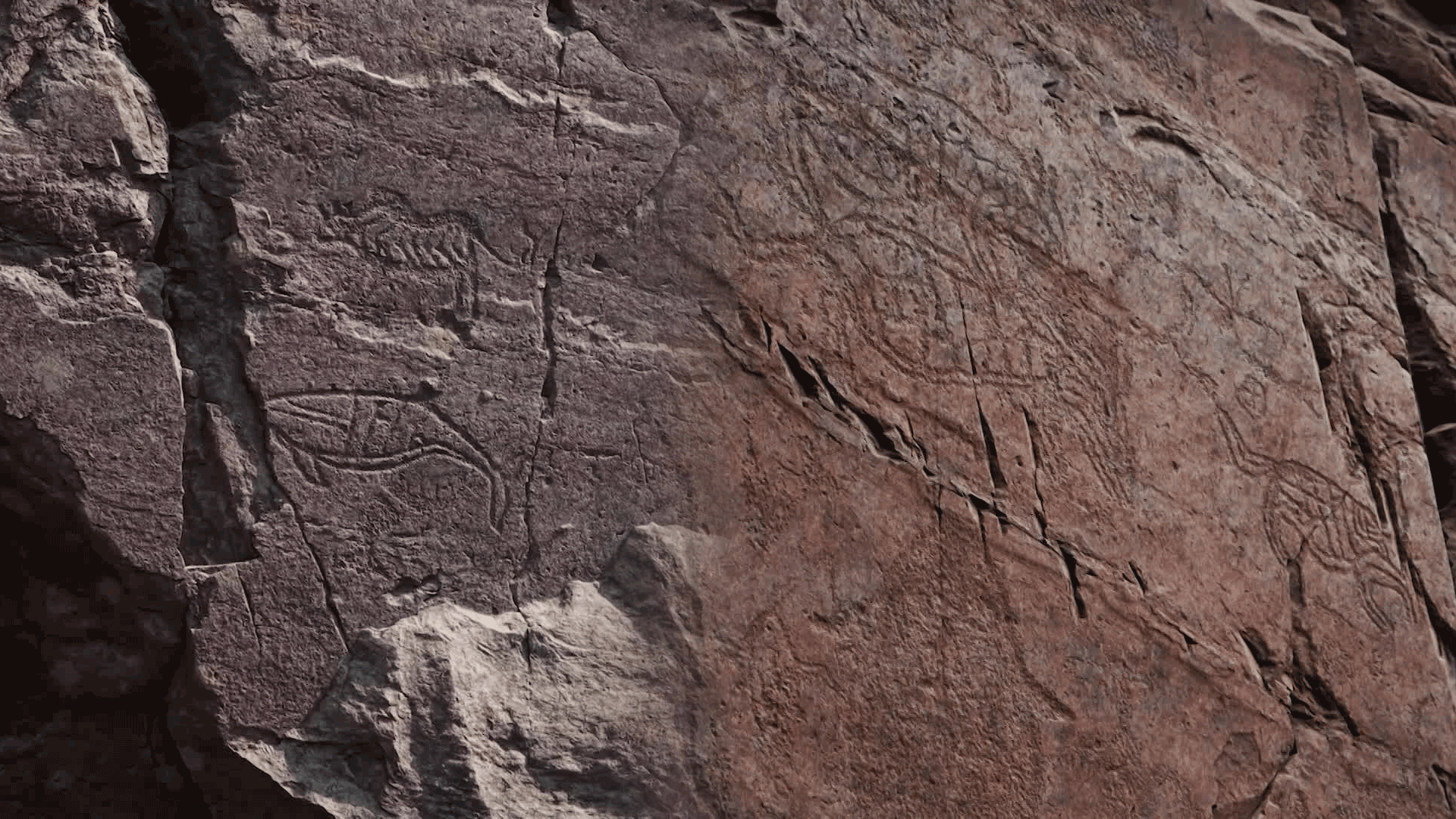S. Korea conducts first ship-launched UAV combat test
입력 2024.11.14 (00:44)
읽어주기 기능은 크롬기반의
브라우저에서만 사용하실 수 있습니다.
[Anchor]
Our military has successfully conducted its first combat experiment by launching a large unmanned aerial vehicle from a naval vessel floating on the sea.
The deck of the ship served as a runway, and it is expected that the operation of unmanned aerial vehicles over the sea will be further expanded in case of emergencies.
Reporter Song Geum-han reports.
[Report]
A state-of-the-art fixed-wing unmanned aerial vehicle, with a wingspan of 16 meters and a fuselage length of 9 meters, is moved from the hangar to the deck of the ship.
This is a prototype of the latest American unmanned aerial vehicle 'Mojave,' which can fly continuously for three and a half hours at speeds close to 260 km/h.
The unmanned aerial vehicle attempts to take off from the deck of the Dokdo-class amphibious assault ship of the South Korean Navy.
Successfully taking off, the 'Mojave' flew over the East Sea while maintaining stable communication with the Naval Air Command.
It also demonstrated a simulated landing maneuver by passing closely over the Dokdo ship.
["The unmanned aerial vehicle is currently simulating the landing procedure as it passes closely to the port side of the ship."]
The combat experiment of the fixed-wing unmanned aerial vehicle, which took off from a ship, was successfully completed as it landed on the runway of the Pohang Naval Air Command, located 60 km away from the Dokdo ship.
Fixed-wing unmanned aerial vehicles are faster and have a wider operational range than rotary-wing unmanned aerial vehicles, which have rotating wings like helicopters, but they require a long runway for takeoff and landing.
The Mojave unmanned aerial vehicle used in this experiment is specially designed to take off from the deck of a naval vessel, requiring a distance of less than 100 meters for takeoff.
[Kim Byeong-jae/Brigadier General/Director of Naval Force Analysis, Test & Evaluation Group: "Based on the results derived from the combat experiment, we will do our best to establish a solid military readiness posture by building a marine manned-unmanned composite system."]
Currently, only the first prototype of the Mojave has been produced, and it is expected to be complete in development as early as in three years.
As the operation of unmanned aerial vehicles from ships expands, it is anticipated that they will be able to identify and attack maritime targets in cooperation with maritime patrol aircraft, enhancing maritime operational capabilities.
This is Song Geum-han from KBS News.
Our military has successfully conducted its first combat experiment by launching a large unmanned aerial vehicle from a naval vessel floating on the sea.
The deck of the ship served as a runway, and it is expected that the operation of unmanned aerial vehicles over the sea will be further expanded in case of emergencies.
Reporter Song Geum-han reports.
[Report]
A state-of-the-art fixed-wing unmanned aerial vehicle, with a wingspan of 16 meters and a fuselage length of 9 meters, is moved from the hangar to the deck of the ship.
This is a prototype of the latest American unmanned aerial vehicle 'Mojave,' which can fly continuously for three and a half hours at speeds close to 260 km/h.
The unmanned aerial vehicle attempts to take off from the deck of the Dokdo-class amphibious assault ship of the South Korean Navy.
Successfully taking off, the 'Mojave' flew over the East Sea while maintaining stable communication with the Naval Air Command.
It also demonstrated a simulated landing maneuver by passing closely over the Dokdo ship.
["The unmanned aerial vehicle is currently simulating the landing procedure as it passes closely to the port side of the ship."]
The combat experiment of the fixed-wing unmanned aerial vehicle, which took off from a ship, was successfully completed as it landed on the runway of the Pohang Naval Air Command, located 60 km away from the Dokdo ship.
Fixed-wing unmanned aerial vehicles are faster and have a wider operational range than rotary-wing unmanned aerial vehicles, which have rotating wings like helicopters, but they require a long runway for takeoff and landing.
The Mojave unmanned aerial vehicle used in this experiment is specially designed to take off from the deck of a naval vessel, requiring a distance of less than 100 meters for takeoff.
[Kim Byeong-jae/Brigadier General/Director of Naval Force Analysis, Test & Evaluation Group: "Based on the results derived from the combat experiment, we will do our best to establish a solid military readiness posture by building a marine manned-unmanned composite system."]
Currently, only the first prototype of the Mojave has been produced, and it is expected to be complete in development as early as in three years.
As the operation of unmanned aerial vehicles from ships expands, it is anticipated that they will be able to identify and attack maritime targets in cooperation with maritime patrol aircraft, enhancing maritime operational capabilities.
This is Song Geum-han from KBS News.
■ 제보하기
▷ 카카오톡 : 'KBS제보' 검색, 채널 추가
▷ 전화 : 02-781-1234, 4444
▷ 이메일 : kbs1234@kbs.co.kr
▷ 유튜브, 네이버, 카카오에서도 KBS뉴스를 구독해주세요!
- S. Korea conducts first ship-launched UAV combat test
-
- 입력 2024-11-14 00:44:08

[Anchor]
Our military has successfully conducted its first combat experiment by launching a large unmanned aerial vehicle from a naval vessel floating on the sea.
The deck of the ship served as a runway, and it is expected that the operation of unmanned aerial vehicles over the sea will be further expanded in case of emergencies.
Reporter Song Geum-han reports.
[Report]
A state-of-the-art fixed-wing unmanned aerial vehicle, with a wingspan of 16 meters and a fuselage length of 9 meters, is moved from the hangar to the deck of the ship.
This is a prototype of the latest American unmanned aerial vehicle 'Mojave,' which can fly continuously for three and a half hours at speeds close to 260 km/h.
The unmanned aerial vehicle attempts to take off from the deck of the Dokdo-class amphibious assault ship of the South Korean Navy.
Successfully taking off, the 'Mojave' flew over the East Sea while maintaining stable communication with the Naval Air Command.
It also demonstrated a simulated landing maneuver by passing closely over the Dokdo ship.
["The unmanned aerial vehicle is currently simulating the landing procedure as it passes closely to the port side of the ship."]
The combat experiment of the fixed-wing unmanned aerial vehicle, which took off from a ship, was successfully completed as it landed on the runway of the Pohang Naval Air Command, located 60 km away from the Dokdo ship.
Fixed-wing unmanned aerial vehicles are faster and have a wider operational range than rotary-wing unmanned aerial vehicles, which have rotating wings like helicopters, but they require a long runway for takeoff and landing.
The Mojave unmanned aerial vehicle used in this experiment is specially designed to take off from the deck of a naval vessel, requiring a distance of less than 100 meters for takeoff.
[Kim Byeong-jae/Brigadier General/Director of Naval Force Analysis, Test & Evaluation Group: "Based on the results derived from the combat experiment, we will do our best to establish a solid military readiness posture by building a marine manned-unmanned composite system."]
Currently, only the first prototype of the Mojave has been produced, and it is expected to be complete in development as early as in three years.
As the operation of unmanned aerial vehicles from ships expands, it is anticipated that they will be able to identify and attack maritime targets in cooperation with maritime patrol aircraft, enhancing maritime operational capabilities.
This is Song Geum-han from KBS News.
Our military has successfully conducted its first combat experiment by launching a large unmanned aerial vehicle from a naval vessel floating on the sea.
The deck of the ship served as a runway, and it is expected that the operation of unmanned aerial vehicles over the sea will be further expanded in case of emergencies.
Reporter Song Geum-han reports.
[Report]
A state-of-the-art fixed-wing unmanned aerial vehicle, with a wingspan of 16 meters and a fuselage length of 9 meters, is moved from the hangar to the deck of the ship.
This is a prototype of the latest American unmanned aerial vehicle 'Mojave,' which can fly continuously for three and a half hours at speeds close to 260 km/h.
The unmanned aerial vehicle attempts to take off from the deck of the Dokdo-class amphibious assault ship of the South Korean Navy.
Successfully taking off, the 'Mojave' flew over the East Sea while maintaining stable communication with the Naval Air Command.
It also demonstrated a simulated landing maneuver by passing closely over the Dokdo ship.
["The unmanned aerial vehicle is currently simulating the landing procedure as it passes closely to the port side of the ship."]
The combat experiment of the fixed-wing unmanned aerial vehicle, which took off from a ship, was successfully completed as it landed on the runway of the Pohang Naval Air Command, located 60 km away from the Dokdo ship.
Fixed-wing unmanned aerial vehicles are faster and have a wider operational range than rotary-wing unmanned aerial vehicles, which have rotating wings like helicopters, but they require a long runway for takeoff and landing.
The Mojave unmanned aerial vehicle used in this experiment is specially designed to take off from the deck of a naval vessel, requiring a distance of less than 100 meters for takeoff.
[Kim Byeong-jae/Brigadier General/Director of Naval Force Analysis, Test & Evaluation Group: "Based on the results derived from the combat experiment, we will do our best to establish a solid military readiness posture by building a marine manned-unmanned composite system."]
Currently, only the first prototype of the Mojave has been produced, and it is expected to be complete in development as early as in three years.
As the operation of unmanned aerial vehicles from ships expands, it is anticipated that they will be able to identify and attack maritime targets in cooperation with maritime patrol aircraft, enhancing maritime operational capabilities.
This is Song Geum-han from KBS News.
-
-

송금한 기자 email@kbs.co.kr
송금한 기자의 기사 모음
-
이 기사가 좋으셨다면
-
좋아요
0
-
응원해요
0
-
후속 원해요
0















이 기사에 대한 의견을 남겨주세요.